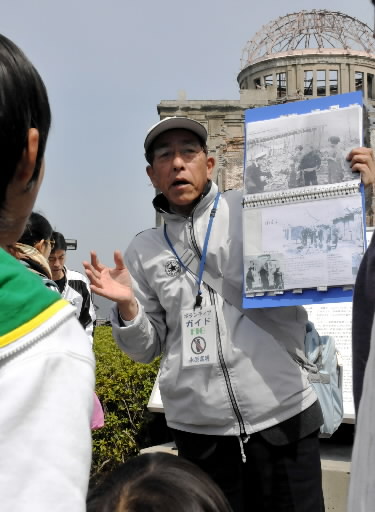Nuclear Weapons Can Be Eliminated: Chapter 9, Part 3
Apr. 17, 2010
Chapter 9: Messengers from Hiroshima
Part 3: Tomiaki Nagahara
by Junichiro Hayashi, Staff Writer
About 2,000 people from Japan, including roughly 100 from Hiroshima, among them A-bomb survivors (hibakusha), will head to the United States in time for the Nuclear Non-proliferation Treaty (NPT) Review Conference to be held at U.N. headquarters in New York from May 3-28. They will visit the United States to appeal for the necessity of eliminating nuclear weapons. The Chugoku Shimbun will track their hopes and resolve with regard to the NPT Review Conference as well as the feelings of those who cannot visit the United States due to advanced age or poor health.
In early April, when Hiroshima was colored with blooming cherry blossoms, about 40 people gathered around a man in front of the Atomic Bomb Dome in downtown Hiroshima. The man, Tomiaki Nagahara, 63, a resident of the city of Kure and a second-generation A-bomb survivor (hibakusha), was holding up pictures of the atomic bombing drawn by hibakusha and photos of victims of nuclear testing in the world. He appealed to the group: "Hiroshima isn't really over. Please don't forget this."
Invited by acquaintances, Mr. Nagahara began appearing in front of the A-bomb Dome in February 2007, volunteering to guide visitors to Hiroshima around the area. He has described the devastation of the atomic bombing to about 19,000 people so far and led them through the neighborhood of the hypocenter. "Their expressions gradually change," he said, "and some even shed tears." In May, he will join the delegation of the Hiroshima Council against Atomic and Hydrogen Bombs visiting the United States in conjunction with the upcoming Nuclear Non-proliferation Treaty (NPT) Review Conference.
Until ten years ago, Mr. Nagahara felt distant from the atomic bombing. In fact, he was born in the city of Shobara in the northern part of Hiroshima Prefecture and grew up without knowing that he was a second-generation A-bomb survivor. His father, a soldier, experienced the atomic bombing near Hiroshima Castle, about one kilometer from the hypocenter, and helped dispose of dead bodies for the next two weeks. When his father died in 2000 at the age of 82, his mother told him about his father's experience for the first time. Mr. Nagahara suddenly began to see the atomic bombing as an intimate part of his life.
What had his father been thinking over the years, while keeping silent about his experience? As Mr. Nagahara read a large volume of writing by hibakusha, he learned about their suffering, their wounds both physical and mental. "The atomic bombing was a grave crime and made the survivors wary of even speaking out," he said.
In 2005, as he neared the age of retirement at his company, Mr. Nagahara joined the Hiroshima Prefectural Confederation of A-bomb Sufferers Organizations, chaired by Kazushi Kaneko. In January 2009, he took part in an A-bomb exhibition which was organized by the Japan Council against Atomic and Hydrogen Bombs and held in Malaysia. Students at the local university looked at photos of the burned-out city and were shocked to discover that only one bomb had wrought such damage. Seeing these students, who had been struck speechless, Mr. Nagahara became keenly aware of the importance of communicating the consequences of the atomic bombing overseas.
In anticipation of the NPT Review Conference, Mr. Nagahara has been involved in a petition drive to convey the wish for nuclear abolition to the United States. One day, a woman who had added her signature to the petition lingered and told him, "Thank you." At first, Mr. Nagahara wasn't certain why the woman was thanking him. But when he asked, she revealed that she was an A-bomb survivor, too. She was offering words of gratitude for "conveying my feelings." The woman reminded him of his father, who had kept "that day" to himself.
When he travels to the United States, Mr. Nagahara will bring A-bomb-related materials and broken pieces of A-bombed roof tiles that he typically uses while guiding visitors around the hypocenter area. During his stay in the United States, he plans to visit the nuclear test site in Nevada as well. More than 900 nuclear tests have been conducted at the site and each test has contributed to the immense number of nuclear weapons that exist today.
"I have something to convey in the United States," said Mr. Nagahara. "Hiroshima has been reconstructed well. But the suffering of the hibakusha still continues."
(Originally published on April 15, 2010)
To comment on this article, please click the link below. Comments will be moderated and posted in a timely fashion. Comments may also appear in the Chugoku Shimbun newspaper.








